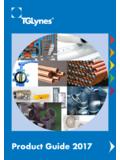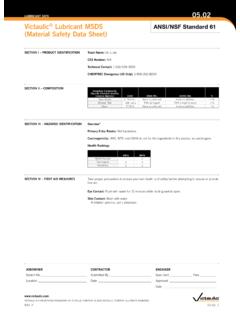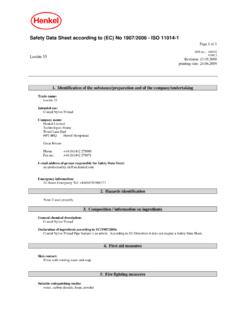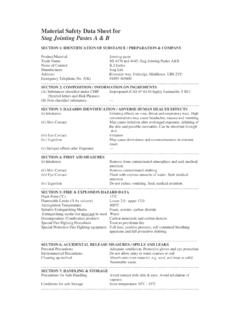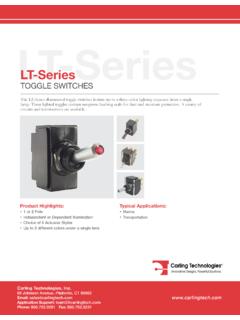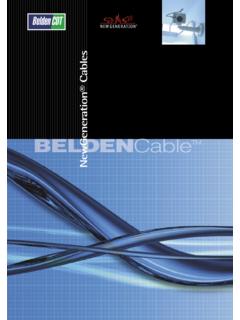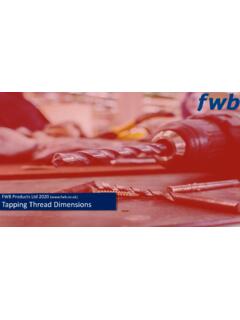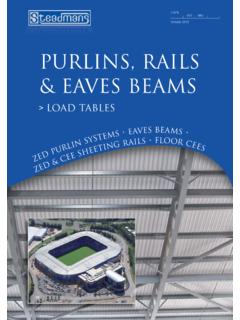Transcription of Hep O Performance Data - TG Lynes
1 41 Hep2O Performance DataStrength and DurabilityPull-out resistanceBS 7291: Part 2: 2001 provides a testprocedure for assessing the pull-outstrengths of pipes from pipes and fittings havebeen tested and offer resistances inexcess of these levels required by BS 7291: 2001are shown in Table pressure resistanceand life expectancyThe ability of a pipe to resist waterpressure depends upon the tensilestrength of the material, whichvaries with pipe has been tested toresist various pressures at varioustemperatures representing normaloperating life cycles. Refer to Table pipes and fittings conformto the long term hydrostaticstrength tests as detailed in BS 7291:Part 1: 2001, Clause life expectancy of not less than 50years can be extrapolated from thisdata, and is based on the range ofintermittent flow temperatures thatthese systems would normallyexperience, ranging between 12 bar20 C and 6 bar 90 exposure to temperatures upto 100 C resulting fromthermostat/system malfunction willnot cause failure, but may shortenthe long term design life of cyclingThermal cycling - the rise and fall inwater temperature during normaloperation - also induces differentand additional stresses on pipes conforms to therequirements of a thermal cyclingtest schedule, to prove the strengthsof a plumbing system, as detailed inBS 7291: Part 1.
2 Scheduleis set out in Table outside pipe diameterBS safe maximum pull-out force10mm380N *15mm705N *22mm1190N *28mm1960N *Table 1 BS 7291: 2001 Pull-Out Force RequirementsTable 2 Operating Temperatures and PressuresPeak life cycle operatingtemperaturesShort malfunction20 C 30 C 40 C 50 C 60 C 70 C 80 C 90 Cat 100 CSafe 1741671601521311161028751 Head of water (m) 1201151101059080706035 Hot waterCold waterMin pressureNo. of cyclesInlet tempDuration Inlet tempDurationBarpsim/head83 2 C20 mins15 5 C10 2 C20 mins15 5 C10 2 C20 mins15 5 C10 3 Thermal Cycling*From BS 7291: Part 2: 2001,Table C1 Effects of FireFlammability and burningIn common with most other organicpolymers and materials used in themanufacturing and constructionindustries, polybutylene will burn. Itis difficult to ignite, however, and isdefined as combustible but nothighly protectionPolybutylene pipe, less than 50mm indiameter, does not need to besleeved in intumescent material whenpassing through a fire resistant Performance Data42 FlexibilityModulus of elasticityModulus of elasticity is a measure ofthe ability of a material to cope modulus of elasticity ofpolybutylene is 400-450 to other materials,including other plastics, this value isvery low.
3 For example, for PVC it is2410N/mm2and for copper129800 means that polybutylene is notdifficult to bend and expansionstresses are low. However,polybutylene is unusual in combiningflexibility with toughness even atelevated temperatures andpressures, ensuring that Hep2O meets the demands of modernheating of pipeworkHep2O pipe can be bent manuallywithout heating for unsupportedbends to a minimum radius of eighttimes the pipe s outside removes the need to insert a90 elbow fitting and results in areduction in loss of head ( a15mm elbow equates to an on the pipe run).The durability of Hep2O pipe andits ability to stretch without damage,allows the minimum bend to bemade cold, without causing kinking on the inside, nor collapse on theoutside of a bend. A reduction ofthe bore is thereby minimised. Referto Figure 1 and Table support bends are neededfor 15mm and 22mm outsidediameter pipes, the use of a ColdForming Bend Fixture (HX75) willgive a radius of eight times the pipediameter, again minimising the loss ofhead in a system.
4 Refer to Figure 2and Table on its diameter, pipe isavailable in coils of up to 100metres (see Product Range section,page 12), which facilitates handlingand handling is also made easier asthis flexibility enables the pipe to bebent around corners and withinconfined pipes will not suffer fatiguestress damage through pipe is approximately 1/4the weight of copper pipe permetre as indicated in Table dia(mm)10 152228A(mm)80120176224 Table 4 Minimum Unsupported Cold-Bend RadiiNominal dia(mm)1522A(mm)120176 Table 5 Cold Form Bend RadiiAFigure 1 Minimum unsupported cold-bendradiiFigure 2 Cold form bend radiiThermal expansionHep2O pipes expand when thetemperature is flexibility of the pipe meansthat the expansion is spread evenlyalong a pipe run eliminatingdamaging movement at a criticalfixed point in the hot, the pipe s expansioncreates undulations, though itsformer length is resumed after thetemperature has pipe runs should thereforebe boxed in to avoid unsightlytemporary coefficient of thermal expansionof polybutylene is x 10-4/m/ means that the pipe expands per metre of pipe for every10 C temperature.
5 Calculate the amount of expansionof a metre pipe installed at 20 Cwhen running at 80 x 2400 x 60 = the pipe is totally restrainedin a concrete floor ( asunderfloor heating), the stresses areso low that they are absorbed bythe dia(mm)10 152228 Weight(g/m)Hep2O4175126210 Copper183281534683Ta ble 6 Hep2O and Copper PipeWeight Comparison43 Thermal Characteristics Thermal conductivityThe thermal conductivity (k) ofpolybutylene is which islow relative to copper. This property,coupled with the approximately 2mmthick pipe walls of Hep2O ,meansthat: the pipe is safe to touch evenwhen conveying water at 60 C. the pipe does not radiate heatquickly, and so will not cool quickly,thereby delivering hot pointThe melting point of polybutylene is125 C, and as a result, blow lampsmust never be played on Hep2O pipes and , the Vicat softening point, at116-117 C, is well above the boilingpoint of water and is also greaterthan the overheat control of gas andoil boilers (approximately 95 C).
6 Connections to boilersWhere boilers incorporate acopper heat exchanger and theconnections are made outside thecasing,Hep2O can be connecteddirectly to the boiler via thecompression nut, if this is locatedmore than 350mm from the heatsource. Typically, these boilerscontain high limit cut-outthermostats and generally have alow water content. See page installation procedures onlyapply for solid fuel boilers, othercast iron heat exchange boilers, orwhere the first connection is madeinside the boiler casing. In theseinstances, where the heat outputmay be uncontrolled, a 1 metre runof copper pipe should be usedbetween the boiler and the start ofthe Hep2O system. See page boiler connections should bemade in accordance with therequirements of BS 5955: Part jointsWhen soldering HX42/10 (a brassdouble spigot reducer in theDemountable range), ensure thatthe solder joint is completed firstand has fully cooled before makingthe push-fit temperaturesHep2O maintains its flexibility intemperatures down to -15 C.
7 Thisproperty significantly reduces thelikelihood of bursts, even at sub-zerotemperatures, when the pipework hasfrozen and the water has expanded involume by becoming pipe accepts this expansionwithout fracturing, and resumes itsoriginal size after a InsulationThermal diffusivityThermal diffusivity is the rate of heatdiffusion throughout a the value the greater the heatdiffusion. The thermal diffusivity of amaterial depends on its thermalconductivity, density and specific Hep2O has a lowerdiffusivity than copper, its insulationrequirements are the same as thoseof copper and should comply withBS 6700, BS 5422 and the protectionThe minimum thicknesses ofinsulation to delay freezing are givenin Table that is potentially exposedto freezing conditions and thereforerequires insulation would typicallybe found in the following areas: unheated roof spaces.
8 Unheated cellars. unheated outbuildings. near windows, airbricks,ventilators, etc. in chases or ducts formed inoutside heating installationsMinimum thicknesses of insulationfor central heating installations aregiven in Table 8. The figures arebased on the temperaturedifferential of 75 C hot face to 20 Cambient and oil fired domestic hotwater installationsThe recommended minimumthicknesses of insulation fordomestic hot water pipework isgiven in Table 9. The figures arebased on the temperaturedifferential of 60 C hot face to 20 Cambient (k)Outdoor (k) diameter(mm)Insulation (mm)Insulation (mm)152232502738632222325027386328223250 273863 Table 7 Frost (k) (k) (k)Pipe diameter(mm)Insulation (mm)151925252225252528252525 Table 8 Central Heating InstallationsInsulation (k) (k) (k)Pipe diameter(mm)Insulation (mm)152532322225323228253232 Table 9 Gas & Oil Fired DomesticHot Water InstallationsInsulation ThicknessesHep2O Performance Data44 Corrosion and ChemicalEffectsCorrosion and oxygen diffusionCorrosion of metals is a hazard ininstallations, therefore it is essentialthat the water oxygen content iskept to an absolute will almost always bepresent in any system as it can enterthrough a variety of points, such asopen header tanks, threaded joints,valves and pumps.
9 However,Hep2O Barrier Pipe will ensurethat oxygen ingress through the pipewall is kept to a heating circuits, whatever thetype of pipe used, should beprotected by an inhibitor, and thenany oxygen entering the system willhave no adverse pipe is unaffected by bothacidic (soft) water or alkaline (hard)water, the most common reasonsfor copper pipe corrosion in all-metal with chemicalsHep2O is not damaged by shorttermcontact with other chemicalscommonly found in a domesticenvironment. These chemicalsinclude: paraffin, diesel oil, carbontetrachloride, bleaches, detergents,turpentine, linseed oil, white spirit,water purification softeners,common adhesives, paints, varnishes,sealers, cement, quick sustained concentrations ofchlorine will have an adverse effecton all plastics pipe. However, suchconcentrations are not usuallyexperienced within the UK watersupply which are very low (less ppm).
10 At these levels, undernormal operating conditions therewill be no adverse effect on the lifeexpectancy of the Hep2O term chlorination fordisinfection will not have an adverseeffect on the ,Hep2O should not beused in installations where sustainedabove average chlorine levels can beanticipated such as swimming long term contact is suspected,the Hepworth Plumbing ProductsTechnical Advisory Service shouldbe consulted on 01709 resistanceHep2O pipe is unaffected by bothacidic (soft) water or alkaline (hard)water, the most common reasonsfor copper pipe scale build-up in all-metal hard water areas, scale or furbuild-up inside Hep2O pipes isresisted by the exceptionallysmooth finish and cleanly abuttingsurfaces within joints. The bore ofthe pipework will therefore bemaintained almost indefinitely, as thescale will not adhere to pipe and fittings have beentested by the Water ResearchCentre and have been found tocomply with the requirements of theWater Regulations.


